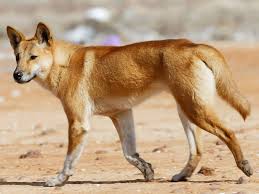
Dingo
Conditions of detention
Dingoes are highly adaptable and can thrive in diverse habitats, including deserts, grasslands, and forests. They typically form packs and establish territories.
Useful Fact: Dingoes are known for their ability to survive in harsh conditions with minimal resources, often traveling long distances in search of food.
Nutrition and diet
Dingoes are opportunistic feeders with a diet that includes small to medium-sized mammals, birds, and reptiles. They also scavenge carrion and can consume fruits and plants.
Useful Fact: Their diet varies based on availability, showcasing their adaptability to different environments.
Health
Dingoes are generally robust and healthy animals in the wild. They are less prone to many of the diseases that affect domestic dogs due to their isolation and natural lifestyle.
Useful Fact: The primary health concern for dingoes is human interference, such as poisoning and hunting.
Grooming and care
Dingoes have a short, double coat that is usually a reddish-brown color, though black, tan, and white variations exist. Their coat is designed to withstand extreme temperatures, shedding heavily twice a year.
Useful Fact: Wild dingoes require no grooming, but captive dingoes need regular care similar to domestic dogs, including brushing to manage shedding and routine health check-ups.
Education and training
Training dingoes can be challenging due to their wild instincts and independent nature. They require experienced handlers and a lot of socialization from a young age if kept in captivity.
Useful Fact: Dingoes respond best to positive reinforcement techniques and need consistent training.
Toys and entertainment
Captive dingoes benefit from toys that stimulate their hunting instincts and provide mental enrichment. Puzzle toys and interactive games are ideal.
Useful Fact: Providing enrichment activities can help reduce stress and prevent destructive behaviors in captive dingoes.
Safety
Dingoes are naturally wary of humans, which helps them avoid dangerous encounters. In captivity, secure enclosures are essential to prevent escapes and protect them from potential threats.
Useful Fact: Dingoes are skilled escape artists, so enclosures need to be escape-proof with high fences and secure locks.
Accessories
For captive dingoes, essential accessories include sturdy collars, leashes, and durable toys. They also need secure housing that mimics their natural environment as much as possible.
Useful Fact: Enclosures should include elements like logs, rocks, and water features to keep dingoes engaged and comfortable.
Socialization
Early socialization with humans and other animals is crucial for captive dingoes to ensure they are well-adjusted and manageable.
Useful Fact: Dingoes that are not properly socialized can become highly fearful or aggressive, making them difficult to handle.
Travel and Transportation
Transporting dingoes requires secure, well-ventilated crates. They should be accustomed to travel from a young age to reduce stress.
Useful Fact: Tranquilizers should be avoided unless absolutely necessary, as they can cause adverse reactions in dingoes.
Behavior and psychology
Dingoes are highly intelligent, curious, and social animals. They exhibit complex social structures and communicate through vocalizations, body language, and scent marking.
Useful Fact: Understanding dingo behavior is essential for managing them in captivity and ensuring their well-being.
Legal aspects
Dingo ownership and conservation are regulated in many regions due to their protected status and potential threat to livestock. It is important to be aware of local laws and regulations.
Useful Fact: In Australia, dingoes are protected in many national parks, but they are also subject to control measures in agricultural areas to protect livestock.


